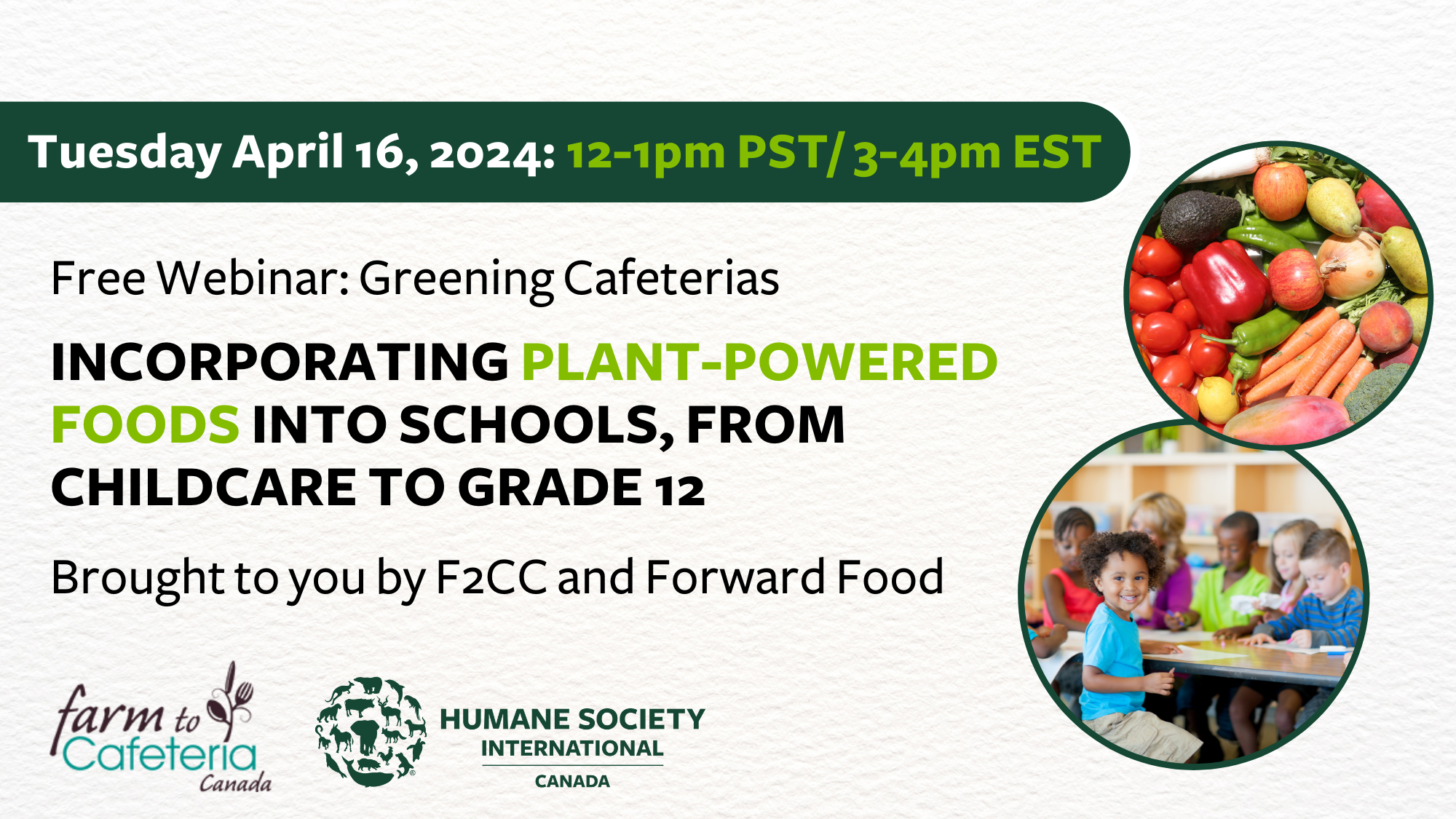An interview with Joanne Bays, National Director, Farm to Cafeteria Canada
In May, nearly 300 leaders from across North America gathered in Victoria BC to take part in Canada’s first National Farm to School Conference – an event designed to illuminate and inspire activity to get more local healthy foods in the minds and on the plates of students. At the conclusion of the conference Joanne Bays, the National Director of Farm to Cafeteria Canada, was interviewed by Marianne Boire a journalist with 100 °. Marianne sought to capture Joanne’s reflections about the conference and plans for the coming year. A streamlined English version of the interview is available below. A fuller French version is available here.
Marianne Boire
What was your main purpose with this Conference?
Joanne Bays
We wanted to illuminate and to celebrate the activity underway in this country to bring more of the local harvest into school classrooms and cafeterias.
We wanted to shift the dialogue about school food from scarcity to abundance. We have so much more than a patchwork quilt of school food programs in Canada. We have created a beautiful tapestry of programs connecting children to their food and their planet.
We wanted to pique a curiosity about the vibrant threads and sequins throughout that tapestry – the innovations, successes and opportunities to advance our work in preschool, school, campus, regional food system, research, and policy settings.
We wanted inspire further action – particularly in the realm of evaluation and research.
What did that Conference bring to the Canadian Farm to School movement?
The knowledge that Farm to School (F2S) is bigger than school lunch – it is about closing the distance between field and fork, and cultivating a generation of healthy eaters and critical thinkers who understand and value food and it’s role in personal, cultural, and planetary health.
The knowledge that F2S activity is flourishing in Canada and beyond our borders. The pan-Canadian Farm to School network championed by Farm to Cafeteria Canada (F2CC) is more than 5,000 members/followers strong, with representatives from from nearly every province and territory. F2CC has developed and maintains the only national map tracking school food activity. Thus far, 1,215 Canadian schools and campuses report they are providing 863,074 students with an opportunity to experience growing, harvesting, preparing and eating healthy local foods at school. These schools estimate they spend ~ $16 M annually on local foods. In the US, Farm to School activity is proliferating in every state. The recent US Farm to School census indicates there are 42,875 school districts engaged in Farm to School investing $789 M into local economies.
The knowledge that, F2S is having impact in Canada. We now have empirical evidence as well as rich case studies in Canada to demonstrate F2S has multiple positive multiple impacts – from improvements in student eating behaviours to improvements in school and regional food systems. Health Canada has recently approved the release of a new Farm to School Food Guide illuminating the impacts of a national Farm to School initiative made possible with significant federal support and funding.
The knowledge that Canada’s F2S movement is solidly supported by both public and private sector. During the opening ceremony, Canada’s Minister of Health, Honourable Ginette Petitpas Taylor, provided a warm welcome via letter, speaking about her support of F2CC and the national F2S activity the organization is championing. At the close of the first day, Nona Evans, the CEO of the Whole Kids Foundation, and Grant Daisley, Communications Director for Whole Foods Stores, announced another $500 K investment to enable more schools in more provinces to bring more of the local harvest into their cafeterias. Later that evening, during a harvest reception dinner, BC’s Minister of Agriculture, the Honourable Lana Popham, spoke about her support for F2S and the way she is accelerating the realization of the F2S vision through her Ministry’s Grow BC, Feed BC, Buy BC initiative. And, likewise, on the second day of the conference, Canada’s Minister of Agriculture and Agri-Food, Honourable Marie Claude Bibeau, released a video endorsing the F2S vision more healthy local sustainable foods on the minds and plates of students.
Why did you decide to focus on the importance to produce and use evidence? How do you think, or wish, people could use this message on the ground, in schools projects, or advocacy for the Farm to school movement?
We recognize there is power in proof. We need only to look south of the border to see this power. The US Farm to School Network tracked Farm to School activity across the nation, gathering case studies and stories, and then ensured this data found its way to policy makers. This concerted effort by multiple partners from local to national levels to gather the right data, at the right time and to place it in front of the right people lead to the establishment of a National Farm to School Census and then to the formal creation of a Farm to School program within the USDA.
In Canada, the school food and Farm to School movements have been quite effective in gathering evidence to demonstrate student access to healthy local sustainable foods is a legitimate concern and that action on this front would receive broad public support. However, our recipe for success is not yet entirely clear. Policy makers, funders, parents and others seek the recipe. They want evidence that feasible solutions exist.
F2CC, with its partners’ focus and expertise in research and evaluation of promising practices, is uniquely positioned to illuminate the recipe that Canada seeks. Those who believe that every child should have an opportunity to experience the joy of Farm to School can help advance that vision by contacting F2CC and sharing their activity on our national map, or by submitting their stories of success.
What are the next steps for the Farm to School movement in Canada?
In the upcoming weeks F2CC and our partners shall most certainly act on the invitations of Ministry staff to meet and to share existing evidence and plans and to advocate for further action.
In the fall or winter of 2019 F2CC shall announce the 3rd cycle of Farm to School Canada grants as a measure to scale up and sustain our momentum.
Over the next 18-24 months F2CC shall facilitate a panCanadian series of table talks in classrooms, in kitchens, community centres, and in boardrooms in order to develop an evaluation framework for Farm to School Canada.
What can we learn from the American Farm to School movement?
A federally funded national school meal program has been in place in the US since 1946. We should take a good look at the US program – its strengths and its weaknesses. Importantly we should pay attention to the focus in this past decade on Farm to School.
As it turns out the Farm to School movement in the US was born in response to two critical issues: 1) the growing epidemic of childhood obesity and the need to get school children eating more fresh fruits and vegetables and less processed and packaged foods (which were standard fare in the national school meal program); and 2) the farming and economic crisis in the US. Putting policy and resources in place to get more local foods on student’s plates was seen as a measure to fuel community economic growth.
Canada faces the similar contextual challenges – and in addition to the two that prompted recent US Farm to School activity we face pressing issues of child hunger and food insecurity, retaining indigenous foods and food ways, and climate change.
I believe we should be reaching high with our ask of those in positions of power, insisting on adequately resourced transformative regional and school food systems change – because our children and our planet deserve no less.
I also believe we shouldn’t wait for our government to act. We need to continue to roll up our sleeves, and to show the state, the funders, and others who hold the purse strings the multiple ways and means our vision can be realized in all the various contexts in Canada.
What is your dream for the Canadian Farm to School Movement?
I have this big, bold, beautiful dream born out of love for my daughter, my community, and my planet.
In my dream…
- Every child has an opportunity to experience the joy of Farm to School.
- Every school has a garden, a kitchen, a dining and a composting area.
- Every school affords students adequate time to eat.
- Food is acknowledged as an academic subject in curriculum across Canada.
- Every school is an oasis from corporate influence – schools are “food advertising free zones”.
- Every school has a policy to procure and serve as much healthy, local, sustainably produced, minimally processed and packaged foods as possible.
- Every community in Canada has a vibrant, thriving, regional food system that prioritizes the sustainable production, processing, and delivery of foods to schools.
- Akin to the National Health Care Act, the government of Canada works with provincial governments, territories, and indigenous nations, to develop and put in place a national Farm to School Act.
The details of the National Farm to School Act? Well, THAT is the substance of another full article…





